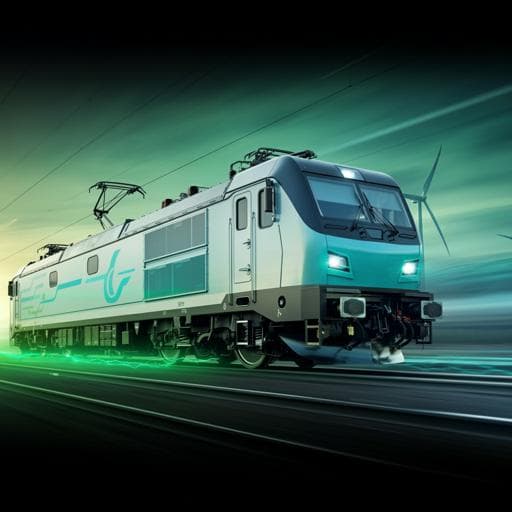
Transportation
Economic, environmental and grid-resilience benefits of converting diesel trains to battery-electric
N. D. Popovich, D. Rajagopal, et al.
This groundbreaking research by Natalie D. Popovich, Deepak Rajagopal, Elif Tasar, and Amol Phadke explores the potential of battery-electric locomotives to revolutionize the US freight rail sector. Experience substantial reductions in CO2 emissions and significant cost savings derived from innovative battery technology and renewable energy integration.
~3 min • Beginner • English
Introduction
The study addresses whether US freight rail can feasibly and economically transition from diesel-electric to battery-electric propulsion to achieve substantial greenhouse gas and air-pollution reductions while maintaining operational practicality. The context is the need for a 45% reduction in global GHG emissions from 2010 levels by 2030 to limit warming to 1.5°C. US freight rail transports about 40% of national freight and relies predominantly on diesel fuel, emitting 35 Mt CO₂ annually and causing roughly 1,000 premature deaths per year with about US$6.5 billion in health damages. Although locomotives are fuel-efficient relative to trucks, their per-unit pollution damages are high. Regulatory measures (for example, catalytic converters) reduce NOₓ and PM₂.₅ but do not affect GHG emissions. Zero-emission pathways under consideration include overhead catenary electrification, hydrogen fuel cells and battery-electric locomotives. Catenary has been more extensively studied but faces high US-specific costs and clearance constraints; hydrogen’s emissions depend on production pathways and is predominantly fossil-derived today. Motivated by rapid declines in battery prices, increases in energy density, and the potential to use low-cost renewable electricity, this paper evaluates battery-electric rail as a retrofit pathway leveraging existing diesel-electric drivetrains and surplus renewable electricity, and examines conditions for cost parity with diesel.
Literature Review
Prior work and sector initiatives explore catenary electrification and hydrogen fuel cells for zero-emission freight rail. Catenary systems are common internationally but face cost and infrastructure challenges in the US, including higher estimated construction costs and double-stack container clearance requirements. Hydrogen fuel cells have gained attention, yet life-cycle emissions hinge on hydrogen sources; most hydrogen is currently fossil-based. Battery technology advances are notable: between 2010 and 2020, battery energy densities roughly tripled and pack prices declined by about 87%, with projections of US$100/kWh by the early 2020s and US$58/kWh by 2030. Previous studies often used average service-level electricity tariffs, likely overestimating charging costs by not accounting for time-varying wholesale prices, access to surplus renewables, and economies of scale for high-volume routes. Demonstrations (for example, a California battery-electric locomotive project) and passenger applications (Japan) suggest feasibility for meaningful ranges, though comprehensive performance data are limited.
Methodology
Scope: The analysis focuses on US Class I railroads (94% of 2019 freight rail revenue). The approach evaluates technical feasibility, charging infrastructure costs, and economic performance via total cost of ownership (TCO) and sector-wide net present value (NPV) over a 20-year horizon.
Technical feasibility and sizing: The study considers battery tender cars coupled to existing diesel-electric locomotives to power traction motors via the existing electrical bus. Both a.c. and d.c. motor retrofits are discussed; d.c. requires minimal additional equipment whereas a.c. may require onboard inverters/transformers. Using LFP battery assumptions: cell-specific energy ~210 Wh/kg, pack specific energy ~160 Wh/kg (packing fraction ~0.76), roundtrip efficiency ~95%, and typical packing density assumptions, the estimated combined weight for a 1-MWh battery plus inverter remains within typical US freight constraints (for applicable routes, payload limits ~114 t per boxcar; network bridge limits ~121 t on some sections). Estimated battery volume requirements fit within a standard 14.6-m boxcar volume of ~129 m³. A single standard boxcar equipped with approximately a 14-MWh battery pack and inverter can deliver an average daily range of 241 km (typical for US Class I operations). Battery-powered trains incur added mass but retain an efficiency advantage; the analysis assumes efficiency relative to diesel of ~2.44× and an energy intensity for battery operation around 0.0345 kWh per revenue-tonne-km, considering cooling and power electronics losses. Operationally, average hauls (~1,682 km) include 30–45 min stops every 240–400 km (crew changes) and occasional 1–2 h refueling stops, offering charging opportunities. Commercial LFPs can support high charging rates (~30 min per full charge for cells, ~1.2 C-rate). Battery swapping is identified as a potential but is not modeled.
Charging infrastructure and electricity pricing: The study models a 72-MW fast-charging station connected at transmission level, capable of simultaneously charging multiple tender cars (e.g., two trains, four tender cars each) with baseline assumptions: 80% depth of recharge, 1-hour charge time, ~10% conversion losses, 7% capital return, 20-year station life. Utilization (use factor) is a key driver of levelized charging costs; centralized and scheduled freight operations can enable 30–50% use on most routes, with analyses considering a wider range. Historical wholesale price data from ERCOT and CAISO (2017–2019) inform generation costs and time-of-use charging strategies. Wholesale prices during the lowest-priced 8–12 hours average ~US$17–20/MWh, with a high share of hours under US$30–45/MWh, facilitating low-cost charging by avoiding high-price periods (e.g., critical peak pricing hours in ERCOT occurring <50 hours/year). Levelized unit charging costs include generation, T&D, EVSE/equipment, grid connection, O&M, installation, and capital return components.
Economic analysis (TCO and NPV): TCO is annualized over 20 years at a 3% discount rate, comparing battery-electric with diesel locomotives. Inputs include: battery pack costs US$50–200/kWh (base near-term US$100/kWh), inverter ~US$70/kWh, standard boxcar ~US$135,000, battery life ~5,000 cycles, cycles/day ~1, electricity generation ~US$0.023/kWh, levelized fast-charging infrastructure ~US$0.02–0.09/kWh, diesel prices reflecting rail-reported and US averages (baseline used ~US$0.611/l for sensitivity), and average daily diesel consumption ~1,454 l/day. Environmental externalities valued using estimates for marginal damages of CO₂ (US$125–226/t) and criteria pollutants (NOₓ, PM, SO₂) from diesel combustion and marginal damages from electricity sector emissions consistent with US power mix (2020–2040). Sensitivity analyses vary battery price, charging-station utilization, diesel price, battery lifetime, and environmental damage inclusion to quantify NPV impacts per locomotive and sector-wide.
Key Findings
- Technical feasibility: A 241-km range (average US Class I daily distance) is achievable using a single standard boxcar equipped with a ~14-MWh LFP battery and inverter, satisfying weight and volume constraints (battery/inverter volume ~40% of a standard boxcar). Battery-electric operation maintains higher energy efficiency than diesel (efficiency advantage ~2.44×) and, despite added mass, uses about half the energy of diesel.
- Operational practicality: Existing crew-change and refueling stops (every 240–400 km; 30–45 min; occasional 1–2 h) provide ample charging opportunities on long hauls (~1,682 km average). Commercial LFP technology supports fast charging (~1.2 C), and battery swapping, though not modeled, may further enhance flexibility; freight boxcars often idle up to ~25 hours, enabling swap logistics where staffed and high-throughput.
- Electricity cost windows: In ERCOT and CAISO (2017–2019), 60–76% of hours were priced under US$30/MWh and 87–91% under US$45/MWh; average prices during the 8–12 cheapest hours were ~US$17–20/MWh, enabling strategic low-cost charging.
- Cost parity thresholds: Under near-future battery prices (~US$100/kWh), all-inclusive electricity prices (generation plus charging infrastructure) need to be ~US$0.056/kWh at 2019 rail diesel prices (~US$0.56/l) to match diesel TCO; with US$50/kWh batteries, ~US$0.074/kWh achieves parity. With access to wholesale prices, critical-peak avoidance, and ~40% charging-station utilization, railroads could realize electricity costs below ~US$0.077/kWh, enabling parity even excluding environmental damages. Including environmental costs further relaxes required electricity-plus-infrastructure prices for break-even.
- TCO per locomotive (20 years): Battery-electric tender cars (including maintenance of the existing diesel engine to retain dual-fuel capability) cost approximately US$6.47–8.00 million versus diesel locomotives at ~US$8.55–11.83 million, depending on inclusion of environmental damages.
- Sector-wide NPV and savings: Accounting for reduced criteria air pollutants and CO₂ emissions, transitioning to battery-electric propulsion yields sector-wide savings of about US$94 billion over 20 years. Additional reported sector-wide results indicate savings on the order of US$151 billion considering electricity-related factors, ~US$44 billion from pollution abatement, and ~US$94 billion from CO₂ reductions.
- Sensitivity drivers: The largest uncertainties in per-locomotive NPV over 20 years are charging-station utilization rates and diesel fuel prices; battery price and lifetime also materially affect outcomes but to a lesser extent.
- Grid-resilience co-benefits: A fully battery-electric freight rail sector could provide over 200 GWh of modular, mobile storage, dispatchable to alleviate local grid constraints and support the power system during extreme events, with charging aligned to low-cost renewable generation windows.
Discussion
The findings show that retrofitting diesel-electric locomotives with battery tender cars is technically feasible for typical US operating ranges and can be economically competitive with diesel in the near term under realistic conditions. By leveraging wholesale market structures, real-time pricing, and critical-peak avoidance, rail operators can substantially lower charging costs through time-shifting to low-price, high-renewable hours. The substantially higher propulsion efficiency of electric drivetrains (relative to diesel) drives large energy savings, while avoided tailpipe emissions significantly reduce health damages. Including monetized environmental damages strengthens the economic case for battery-electric rail. Operationally, scheduled stops offer natural charging windows, and potential battery swapping could further improve availability, though it was not modeled in the core analysis. Beyond decarbonization and public health gains, sector-wide deployment of battery tender cars creates a large, mobile storage fleet that can enhance grid resilience by addressing localized constraints and aiding during extreme events. Policy measures (for example, enabling access to wholesale tariffs, implementing critical-peak pricing structures, or internalizing air-pollution damages) can accelerate parity and adoption. The results directly address the initial question by establishing both technical feasibility and pathways to economic parity while highlighting the broader system benefits.
Conclusion
This study demonstrates that battery-electric propulsion for US Class I freight rail is a technically viable and economically compelling pathway for decarbonization and pollution reduction. A single battery tender car (~14 MWh) can deliver the typical daily range (241 km) within weight and volume limits and with roughly half the energy use of diesel. Under near-term battery prices (~US$100/kWh) and with access to wholesale electricity pricing and moderate charging-station utilization (~40%), battery-electric trains can reach or surpass cost parity with diesel, even before accounting for environmental damages; including such damages further favors battery-electric operation. Over a 20-year horizon, TCO per locomotive is lower for battery-electric configurations, and sector-wide savings can reach tens to over a hundred billion dollars, alongside health and climate benefits. The approach also offers grid-resilience advantages via a large pool of mobile storage capable of charging predominantly during renewable-rich, low-cost hours. Future research should refine rate design and tariff access for rail charging, assess operational strategies such as battery swapping and charging logistics at crew-change points, quantify detailed grid-integration impacts and resilience services, and compare long-run infrastructure trade-offs among battery, hydrogen, and catenary electrification across diverse US corridors.
Limitations
Key limitations include: (1) reliance on historical wholesale price data (ERCOT and CAISO, 2017–2019) and assumptions about rail access to wholesale/real-time pricing, which may vary by market and regulation; (2) charging-station utilization rates (often assumed at 30–50%) drive levelized costs and may differ across routes and over time; (3) battery cost, lifetime (5,000 cycles), and performance projections introduce uncertainty; (4) battery swapping and certain operational flexibilities were noted but not modeled; (5) infrastructure cost estimates (e.g., EVSE, grid connection) and diesel price baselines are subject to change and regional variability; (6) emissions damages reflect median estimates and an average US generation mix that is evolving, affecting comparative externalities; and (7) comparisons with alternative technologies (e.g., catenary) use cost ranges with high uncertainty and limited US freight-specific data.
Related Publications
Explore these studies to deepen your understanding of the subject.







